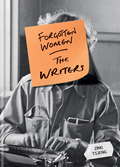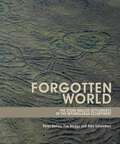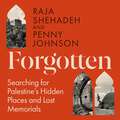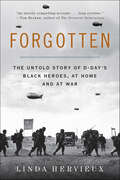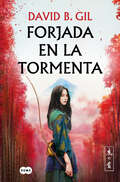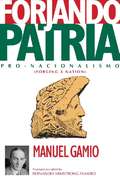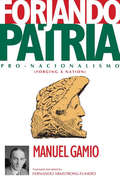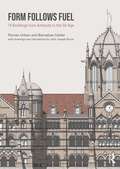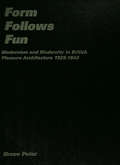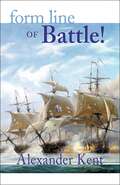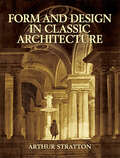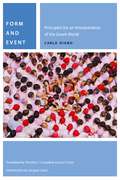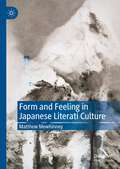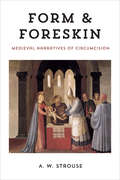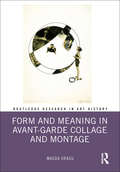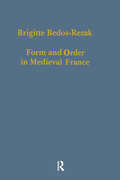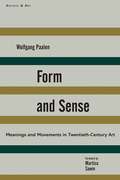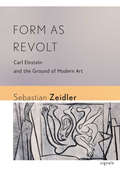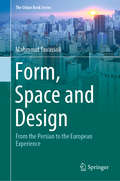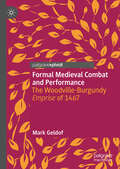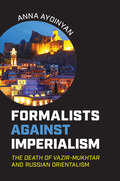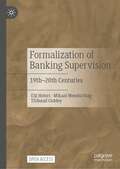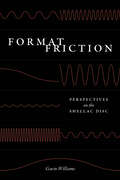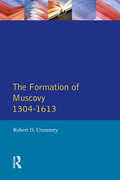- Table View
- List View
Forgotten Women: The Writers (Forgotten Women)
by Zing Tsjeng'To say this series is "empowering" doesn't do it justice. Buy a copy for your daughters, sisters, mums, aunts and nieces - just make sure you buy a copy for your sons, brothers, dads, uncles and nephews, too.' - IndependentThe women who shaped and were erased from our history.Forgotten Women is a new series of books that uncover the lost herstories of influential women who have refused over hundreds of years to accept the hand they've been dealt and, as a result, have formed, shaped and changed the course of our futures. The Writers celebrates 48* unsung genius female writers from throughout history and across the world, including the Girl Stunt Reporters, who went undercover to write exposés on the ills of 1890s America; Aemilia Lanyer, the contemporary of Shakespeare whose polemical re-writing of The Bible's Passion Story is regarded as one of the earliest feminist works of literature; and Sarojini Naidu, the freedom fighter and 'Nightingale of India' whose poetry echoed her political desire for Indian independence.Including writers from across a wide spectrum of disciplines including poets, journalists, novelists, essayists and diarists, this is an alternative gynocentric history of literature that will surprise, empower, and leave you with a reading list a mile long.*The number of Nobel-prize-winning women.
Forgotten World: The Stone-Walled Settlements of the Mpumalanga Escarpment
by Peter Delius Tim Maggs Alex SchoemanIf you drive through Mpumalanga with an eye on the landscape flashing by, you may see, near the sides of the road and further away on the hills above and in the valleys below, fragments of building in stone as well as sections of stone-walling breaking the grass cover. Endless stone circles, set in bewildering mazes and linked by long stone passages, cover the landscape stretching from Ohrigstad to Carolina, connecting over 10 000 square kilometres of the escarpment into a complex web of stone-walled homesteads, terraced fields and linking roads. Oral traditions recorded in the early twentieth century named the area Bokoni – the country of the Koni people. Few South Africans or visitors to the country know much about these settlements, and why today they are deserted and largely ignored. A long tradition of archaeological work which might provide some of the answers remains cloistered in universities and the knowledge vacuum has been filled by a variety of exotic explanations – invoking ancient settlers from India or even visitors from outer space – that share a common assumption that Africans were too primitive to have created such elaborate stone structures. Forgotten World defies the usual stereotypes about backward African farming methods and shows that these settlements were at their peak between 1500 and 1820, that they housed a substantial population, organised vast amounts of labour for infrastructural development, and displayed extraordinary levels of agricultural innovation and productivity. The Koni were part of a trading system linked to the coast of Mozambique and the wider world of Indian Ocean trade beyond. Forgotten World tells the story of Bokoni through rigorous historical and archaeological research, and lavishly illustrates it with stunning photographic images.
Forgotten: Searching for Palestine’s Hidden Places and Lost Memorials
by Raja Shehadeh Penny JohnsonForgotten is a search for hidden or neglected memorials and places in historic Palestine - now Israel and the Occupied Palestinian Territories - and what they might tell us about the land and the people who live on our small slip of earth between the Mediterranean Sea and the Jordan River.From ancient city ruins to the Nabi 'Ukkasha mosque and tomb, acclaimed writers and researchers Raja Shehadeh and Penny Johnson ask: what has been memorialised, and what lies unseen, abandoned or erased - and why? Whether standing on a high cliff overlooking Lebanon or at the lowest land-based elevation on earth at the Dead Sea, they explore lost connections in a fragmented land.In elegiac, elegant prose, Shehadeh and Johnson grapple not only with questions of Israeli resistance to acknowledging the Nakba - the 1948 catastrophe for Palestinians - but also with the complicated history of Palestinian commemoration today.
Forgotten: The Untold Story of D-Day's Black Heroes, at Home and at War
by Linda Hervieux"An utterly compelling account of the African Americans who played a crucial and dangerous role in the invasion of Europe. The story of their heroic duty is long overdue.” —Tom Brokaw, author of The Greatest GenerationThe injustices of 1940s Jim Crow America are brought to life in this extraordinary blend of military and social history—a story that pays tribute to the valor of an all-Black battalion whose crucial contributions at D-Day have gone unrecognized to this day.In the early hours of June 6, 1944, the 320th Barrage Balloon Battalion, a unit of African-American soldiers, landed on the beaches of France. Their orders were to man a curtain of armed balloons meant to deter enemy aircraft. One member of the 320th would be nominated for the Medal of Honor, an award he would never receive. The nation’s highest decoration was not given to Black soldiers in World War II.Drawing on newly uncovered military records and dozens of original interviews with surviving members of the 320th and their families, Linda Hervieux tells the story of these heroic men charged with an extraordinary mission, whose contributions to one of the most celebrated events in modern history have been overlooked. Members of the 320th—Wilson Monk, a jack-of-all-trades from Atlantic City; Henry Parham, the son of sharecroppers from rural Virginia; William Dabney, an eager 17-year-old from Roanoke, Virginia; Samuel Mattison, a charming romantic from Columbus, Ohio—and thousands of other African Americans were sent abroad to fight for liberties denied them at home. In England and Europe, these soldiers discovered freedom they had not known in a homeland that treated them as second-class citizens—experiences they carried back to America, fueling the budding civil rights movement.In telling the story of the 320th Barrage Balloon Battalion, Hervieux offers a vivid account of the tension between racial politics and national service in wartime America, and a moving narrative of human bravery and perseverance in the face of injustice.
Forjada en la tormenta
by David B. GilUn cuento japonés de crimen y misterio por el autor de El guerrero a la sombra del cerezo Asaemon Hikura, maestro rastreador del clan Sugawara, es reclamado para investigar la desaparición de cinco mujeres en una aldea alejada de la capital. Los lugareños culpan de la desgracia a una criatura sobrenatural que, dicen, habita la montaña, pero Asaemon sabe bien que no existe demonio más cruel que aquel que vive entre nosotros. Acompañado de Yumiko, una joven cazadora local que le servirá de guía y confidente, el samurái se lanzará a una búsqueda desesperada. En la misma región, Nanami, hija de un forjador de katanas, trata de ocultar su romance con el joven samurái que administra su aldea. Una relación que contraviene la ley y la voluntad de sus padres. Cuando la guerra llama a sus puertas, Nanami se ve obligada a elegir entre la lealtad hacia su familia y la persona a la que se sabe unida por el karma. Sudecisión influirá de forma insospechada en el destino de las cinco jóvenes desaparecidas. Un relato policiaco con una ambientación insólita, enmarcado en un Japón rural de sugerentes paisajes y oscuros secretos, de la mano del autor que ha puesto de moda la épica samurái en la novela histórica española.
Forjando Patria
by Fernando Armstrong-Fumero Manuel GamioOften considered the father of anthropological studies in Mexico, Manuel Gamio originally published Forjando Patria in 1916. This groundbreaking manifesto for a national anthropology of Mexico summarizes the key issues in the development of anthropology as an academic discipline and the establishment of an active field of cultural politics in Mexico. Written during the upheaval of the Mexican Revolution, the book has now been translated into English for the first time. Armstrong-Fumero's translation allows readers to develop a more nuanced understanding of this foundational work, which is often misrepresented in contemporary critical analyses. As much about national identity as anthropology, this text gives Anglophone readers access to a particular set of topics that have been mentioned extensively in secondary literature but are rarely discussed with a sense of their original context. Forjando Patria also reveals the many textual ambiguities that can lend themselves to different interpretations. The book highlights the history and development of Mexican anthropology and archaeology at a time when scholars in the United States are increasingly recognizing the importance of cross-cultural collaboration with their Mexican colleagues. It will be of interest to anthropologists and archaeologists studying the region, as well as those involved in the history of the discipline.
Forjando Patria: Pro-Nacionalismo
by Manuel GamioOften considered the father of anthropological studies in Mexico, Manuel Gamio originally published Forjando Patria in 1916. This groundbreaking manifesto for a national anthropology of Mexico summarizes the key issues in the development of anthropology as an academic discipline and the establishment of an active field of cultural politics in Mexico. Written during the upheaval of the Mexican Revolution, the book has now been translated into English for the first time. Armstrong-Fumero's translation allows readers to develop a more nuanced understanding of this foundational work, which is often misrepresented in contemporary critical analyses. As much about national identity as anthropology, this text gives Anglophone readers access to a particular set of topics that have been mentioned extensively in secondary literature but are rarely discussed with a sense of their original context. Forjando Patria also reveals the many textual ambiguities that can lend themselves to different interpretations. The book highlights the history and development of Mexican anthropology and archaeology at a time when scholars in the United States are increasingly recognizing the importance of cross-cultural collaboration with their Mexican colleagues. It will be of interest to anthropologists and archaeologists studying the region, as well as those involved in the history of the discipline.
Form Follows Fuel: 14 Buildings from Antiquity to the Oil Age
by Barnabas Calder Florian UrbanModernists believed that “form follows function.” Form Follows Fuel shows that in fact energy has been the biggest influence on the world’s architecture throughout the history of our species. The availability of energy under different fuel regimes – including human labour, firewood, coal, oil, gas, and renewables – shapes architecture at all scales, from what gets built to how its doors hinge.This book is the first to quantify energy inputs for a range of buildings worldwide and across the historical record. In the process, it challenges today's architects, offers practical solutions to today's ecological crises, and highlights the aspects of today’s buildings that make architecture responsible for 37% of human climate-changing emissions. It reveals the enormously lower impacts of historical alternatives to today’s default building practices.This book shows that the shift to modern fossil fuel use, from the seventeenth century, came to be the most consequential move in the history of architecture as well as in human history in general. This brought about remarkable wealth for the built environment and at the same time unprecedented dangers for our planet, as evidenced by the exacerbating climate emergency.This book consists of 14 accessibly written case studies, illustrated with beautiful and revealing new measured drawings of each project by John Joseph Burns. Each chapter focuses on a single structure in a particular historical context, sometimes contrasted to similar buildings, from subsistence farming to advanced global capitalism. The chapters analyse the consumption of embodied and operational energy in these buildings, and also discuss questions of recycling and adaptive reuse. They complement precise descriptions with hard numbers on materials and construction, using robustly sourced approximations where exact figures are not available. The case studies rely on both published research and the authors’ own calculations and allow systematic comparison across different global regions and historical periods.Cases include architectural icons such as the Great Pyramid of Giza, the Baths of Caracalla, the Mausoleum of Qin Shi Huang, the Seagram Building, and Terminal 1 of Kuala Lumpur International Airport, as well as common types such as a pre-modern stone house, a late-nineteenth-century tenement, and a modernist panel block. Examples are taken from different regions of the world, including ancient China, pre-Columbian Mexico, and modern Europe. This book is an important contribution to architectural historical research, written for students, academics and building professionals as well as for a general audience.
Form Follows Fun: Modernism and Modernity in British Pleasure Architecture 1925–1940
by Bruce PeterAuthoritative and readable, this excellent text, illustrated by a unique pictorial record of period architecture, surveys and examines how and why the architecture of pleasure related to the stylistic and ideological concerns of modernism in 1930s Britain. Responding to the current interest in modernism and packed with a substantial archive of high quality photographs and other documentation, it relates the professional, entrepreneurial and institutional infrastructures affecting the pleasure industry’s architectural development and appearance in 1930s. A broad range of building through which the general public first experienced Modernism are covered, including: commercial – holiday camps, cinemas and greyhound racing stadia municipal and governmental projects – zoos, seaside pavilions, concert halls, and imperial and international exhibitions. Arguing that the responses to modernism through the architecture of pleasure were conditioned by wider debates about the role of design in relation to high and mass culture, this book is an ideal resource for all those interested in architectural history and design in Britain between the wars.
Form Line of Battle (The Richard Bolitho Novels #9)
by Alexander KentThe YEAR IS 1793, England is once again at war. For Richard Bolitho, the renewal of hostilities with France means a fresh command and the chance for action after months of inactivity. However, his mission to support Lord Hood in the monarchist-inspired occupation of Toulon has gone awry. Bolitho and the crew of the Hyperion are trapped by the French near a dry Mediterranean island. The great ship-of-the-line's battered hull begins to groan as her sails snap in the hot wind...
Form and Design in Classic Architecture
by Arthur StrattonMost people recognize at a glance the extraordinarily graceful proportions of classical-style buildings such as London's Syon House and Athenaeum Club and the Banqueting Hall at Whitehall. Few, however, appreciate the underlying geometrical principles that lend these buildings their elegant unity of expression. Form and Design in Classic Architecture explains in simple, direct terms -- and with numerous photographic plates and line illustrations -- the ways in which the relationship of exterior and interior elements creates that unity and sense of completeness.Dozens of edifices by Inigo Jones, the Adam Brothers, Sir Christopher Wren, and other renowned architects appear here, in images accompanied by detailed analyses. The author presents a chapter-by-chapter view of buildings in a variety of shapes, with separate treatments of vestibules, corridors, domed and vaulted ceilings, pavilions, loggias, interior and exterior staircases, porticoes, and colonnades.The informative, readable text and handsome illustrations -- as well as the sheer beauty of the buildings themselves -- make this volume appealing, not only to architects and architectural historians but also to anyone with even a casual interest in architecture and design.
Form and Event: Principles for an Interpretation of the Greek World (Commonalities)
by Carlo DianoCarlo Diano’s Form and Event has long been known in Europe as a major work not only for classical studies but even more for contemporary philosophy. Already available in Italian, French, Spanish, and Greek, it appears here in English for the first time, with a substantial Introduction by Jacques Lezra that situates the book in the genealogy of modern political philosophy.Form and Event reads the two classical categories of its title phenomenologically across Aristotle, the Stoics, and especially Homer. By aligning Achilles with form and Odysseus with event, Diano links event to embodied and situated subjective experience that simultaneously finds its expression in a form that objectifies that experience. Form and event do not exist other than as abstractions for Diano but they do come together in an intermingling that Diano refers to as the “eventic form.” On Diano’s reading, eventic forms interweave subjectively situated and embodied experiences, observable in all domains of human and nonhuman life.A stunning interpretation of Greek antiquity that continues to resonate since its publication in 1952, Form and Event anticipates the work of such French and Italian post-war thinkers as Gilles Deleuze, Alain Badiou, Roberto Esposito, and Giorgio Agamben.
Form and Feeling in Japanese Literati Culture
by Matthew MewhinneyThis book explores how two early modern and two modern Japanese writers – Yosa Buson (1716–83), Ema Saikō (1787–1861), Masaoka Shiki (1867–1902), and Natsume Sōseki (1867–1916) – experimented with the poetic artifice afforded by the East Asian literati (bunjin) tradition, a repertoire of Chinese and Japanese poetry and painting. Their experiments generated a poetics of irony that transformed the lineaments of lyric expression in literati culture and advanced the emergence of modern prose poetry in Japanese literature. Through rigorous close readings, this study changes our understanding of the relationship between lyric form and the representation of self, sense, and feeling in Japanese poetic writing from the late eighteenth through the early twentieth century. The book aims to reach a broad audience, including specialists in East Asian Studies, Anglophone literary studies, and Comparative Literature.
Form and Foreskin: Medieval Narratives of Circumcision
by A. W. StrouseWhy did Saint Augustine ask God to “circumcise [his] lips”? Why does Sir Gawain cut off the Green Knight’s head on the Feast of the Circumcision? Is Chaucer’s Wife of Bath actually—as an early glossator figures her—a foreskin? And why did Ezra Pound claim that he had incubated The Waste Land inside of his uncut member? In this little book, A. W. Strouse excavates a poetics of the foreskin, uncovering how Patristic theologies of circumcision came to structure medieval European literary aesthetics. Following the writings of Saint Paul, “circumcision” and “uncircumcision” become key terms for theorizing language—especially the dichotomies between the mere text and its extended exegesis, between brevity and longwindedness, between wisdom and folly. Form and Foreskin looks to three works: a peculiar story by Saint Augustine about a boy with the long foreskin; Sir Gawain and the Green Knight; and Chaucer’s Wife of Bath’s Tale. By examining literary scenes of cutting and stretching, Strouse exposes how Patristic treatments of circumcision queerly govern medieval poetics.
Form and Meaning in Avant-Garde Collage and Montage (Routledge Research in Art History)
by Magda DraguThis book uses intermedial theories to study collage and montage, tracing the transformation of visual collage into photomontage in the early avant-garde period. Magda Dragu distinguishes between the concepts of collage and montage, as defined across several media (fine arts, literature, music, film, photography), based on the type of artistic meaning they generate, rather than the mechanical procedures involved. The book applies theories of intermediality to collage and montage, which is crucial for understanding collage as a form of cultural production. Throughout, the author considers the political implications, as collages and montages were often used for propagandistic purposes. This book combines research methods used in several areas of inquiry: art history, literary criticism, analytical philosophy, musicology, and aesthetics.
Form and Modernity in Women’s Poetry, 1895–1922: A Line of Her Own (Among the Victorians and Modernists)
by Sarah ParkerWhile W. B. Yeats’s influential account of the ‘Tragic Generation’ claims that most fin-de-siècle poets died, or at least stopped writing, shortly after 1900, this book explodes this narrative by attending to the twentieth-century poetry produced by women poets Alice Meynell, Michael Field (Katharine Bradley and Edith Cooper), Dollie Radford, and Katharine Tynan. While primarily associated with the late nineteenth century, these poets were active in the twentieth century, but their later writing is overlooked in modernist-dominated studies, partly due to this poetry’s adherence to traditional form. This book reveals that these poets, far from being irrelevant to modernity, used these established forms to address contemporary concerns, including suffrage, sexuality, motherhood, and the First World War. The chapters focus on Meynell’s manipulations of metre to contemplate temporality and literary tradition; Michael Field’s use of blank verse to portray the conflicted modern woman; Radford’s adaptation of the aesthetic song-like lyric to tackle the experience of the city, urban crime, and suffrage; and Tynan’s employment of the ballad to soothe bereaved mothers during the First World War. This book ultimately shows that traditional forms played a vital role in shaping mature women poets’ responses to modernity, illuminating debates about form, tradition, and gender in twentieth-century poetry.
Form and Order in Medieval France: Studies in Social and Quantitative Sigillography (Variorum Collected Studies)
by Brigitte Bedos-RezakBy the early 13th century the use of seals in Northern Europe was a generalized phenomenon which involved society as a whole, crossing boundaries of gender, age, religion, and social and professional status. The function traditionally ascribed to seals is the validation of the documents to which they were affixed, but the phenomenon has far wider implications, as is brought out in this collection of studies by Brigitte Bedos-Rezak. In itself a seal could serve as a quasi-amuletic object or a personal adornment, the image impressed from it functioned as a sign conveying identity and power, and the ritual of sealing provided an occasion for the affirmation of status. In her work the author has aimed to use the approaches of statistics, cultural and women’s history and semiotics, as well as the ’traditional’ skills of art history, law and diplomatics, to show the numerous surviving seals can be used to reach into the history of the Middle Ages, and at the same time to explore and test the interpretative models suggested by semiotics and postmodern theories on symbols, representation and meaning.
Form and Sense
by Deborah Rosenthal Wolfgang Paalen Martica SawinWolfgang Paalen was a central figure in internationalist surrealist circles in the late 1930s. Artist and intellectual, he was a European whose fascination with archaic cultures led him finally to Mexico, where he founded the influential magazine DYN in 1941. In the bold texts from DYN that make up Form and Sense, we encounter a unique artistic mind and an oracular voice.Paalen's book is an intellectual delight with essays on cubism, surrealism, the universality of forms in architecture, and the relationships that exist between art and science. He weaves together the new ideas and archaic inspirations in twentieth-century painting and sculpture. His nuanced and original considerations of some key figures--Mondrian, Kandinsky, Picasso--marked Paalen in turn as a significant thinker in the world of modern art.This painter's book, illustrated with carefully chosen examples of the art he examines, makes us not only understand but also experience the rich interplay between idea and image that informs the art of our own time. A new introduction by the scholar Martica Sawin examines Paalen's career, particularly his influential writing on surrealism and abstraction.
Form as Revolt: Carl Einstein and the Ground of Modern Art
by Sebastian ZeidlerThe German writer and art critic Carl Einstein (1885-1940) has long been acknowledged as an important figure in the history of modern art, and yet he is often sidelined as an enigma. In Form as Revolt Sebastian Zeidler recovers Einstein's multifaceted career, offering the first comprehensive intellectual biography of Einstein in English. Einstein first emerged as a writer of experimental prose through his involvement with the anarchist journal Die Aktion. After a few limited forays into art criticism, he burst onto the art scene in 1915 with his book Negro Sculpture, at once a formalist intervention into the contemporary theory and practice of European sculpture and a manifesto for the sophistication of African art. Einstein would go on to publish seminal texts on the cubist paintings of Georges Braque and Pablo Picasso. His contributions to the surrealist magazine Documents (which Einstein cofounded with Georges Bataille), including writings on Picasso and Paul Klee, remain unsurpassed in their depth and complexity. In a series of close visual analyses--illustrated with major works by Braque, Picasso, and Klee--Zeidler retrieves the theoretical resources that Einstein brought to bear on their art. Form as Revolt shows us that to rediscover Einstein's art criticism is to see the work of great modernist artists anew through the eyes of one of the most gifted left-wing formalists of the twentieth century.
Form, Space and Design: From the Persian to the European Experience (The Urban Book Series)
by Mahmoud TavassoliThis book studies the principles of urban spatial organization of historic cities. It can be considered a guide to design, presenting qualitative criteria to satisfy practical needs. The subject is explored through interconnected chapters, each addressing an important aspect of form-space and design values, knowledge and our present problems. In this book the interpretation is artistic and socio-cultural. Discussion is not concentrated on singular urban space but on interrelated spaces and elements across the city, and complexes. Considering the comparative aspects of study, the reader will notice that despite cultural differences, there is a common understanding in artistic creativity and sensibility in the presented examples.
Formal Medieval Combat and Performance: The Woodville-Burgundy Emprise of 1467
by Mark GeldofThis book collects together all contemporary and near-contemporary accounts of the 1467 emprise, a particular performative feat of arms, between Anthony Woodville, Lord Scales—brother of Elizabeth Woodville, wife of King Edward IV of England—and Antoine, &‘Grand Bastard of Burgundy,&’ natural son of Duke Philip &‘the Good&’ of Burgundy. Held at Smithfield, London, this emprise has long interested historians of chivalry because of the detailed accounts of its organization and the commentaries on the combats held over two days. Despite its familiarity to readers of late medieval English and European history, the accounts themselves have not historically been easily accessible, and several of them have never appeared in translation in English before now. This collection gathers those accounts, presents them in readable English editions, and gives historical contexts for their content.
Formalists against Imperialism: <em>The Death of Vazir-Mukhtar</em> and Russian Orientalism
by Anna AydinyanIn January 1829, an angry mob in Tehran murdered Russian poet and diplomat Alexander Griboedov, author of the verse comedy Woe from Wit and architect of the Russian annexation of the north Caucasus from Persia after the Russo-Persian War. A century later, the Russian formalist writer Yury Tynianov wrote a historical novel about the event entitled The Death of Vazir-Mukhtar. In this wide-ranging study, Anna Aydinyan posits that The Death of Vazir-Mukhtar conceptualizes Orientalism fifty years before Edward Said coined the term. She argues that Tynianov parodied historical works on the Caucasus in his novel in order to critique the ways in which exoticizing the East enabled imperialism and colonization. Analysing literary and non-literary texts on Russia’s relationship with Iran, along with the economic and cultural development of Transcaucasia after the Russo-Persian War, Formalists against Imperialism studies Russian culture within the framework of comparative colonialisms and examines the twentieth-century Russian reconsideration of the country’s imperial past.
Formalization of Banking Supervision: 19th–20th Centuries
by Eiji Hotori Mikael Wendschlag Thibaud GiddeyThis open access book is the first attempt to elaborate the formalization phase of banking supervision in eight developed countries—USA, Japan, Sweden, Germany, Switzerland, Belgium, France, and UK. This innovative study in the field of banking supervision history identifies why national histories of banking supervision share similarities, but also remain different and are heavily path dependent. This book will be of great interest not only to financial/economic historians but also to general readers interested in banking supervision, i.e., students, bankers, supervisors, and international officials.
Format Friction: Perspectives on the Shellac Disc (New Material Histories of Music)
by Gavin WilliamsThe first book to consider the shellac disc as a global format. With the rise of the gramophone around 1900, the shellac disc traveled the world and eventually became the dominant sound format in the first half of the twentieth century. Format Friction brings together a set of local encounters with the shellac disc, beginning with its preconditions in South Asian knowledge and labor, to offer a global portrait of this format. Spun at seventy-eight revolutions per minute, the shellac disc rapidly became an industrial standard even while the gramophone itself remained a novelty. The very basis of this early sound reproduction technology was friction, an elemental materiality of sound shaped through cultural practice. Using friction as a lens, Gavin Williams illuminates the environments plundered, the materials seized, and the ears entangled in the making of a sound format. Bringing together material, political, and music history, Format Friction decenters the story of a beloved medium, and so explores new ways of understanding listening in technological culture more broadly.
Formation of Muscovy 1300 - 1613, The (Longman History of Russia)
by Robert O. CrummeyThis is a comprehensive account of the rise of the late medieval Russian monarchy with Moscow as its capital, which was to become the territorial core of the Soviet Union. The legacy of the Grand Princes and Tsars of Muscovy -- a tradition of strong governmental authority, the absence of legal corporations, and the requirement that all Russians contribute to the defence of the nation -- has shaped Russia's historical development down to our own time.
